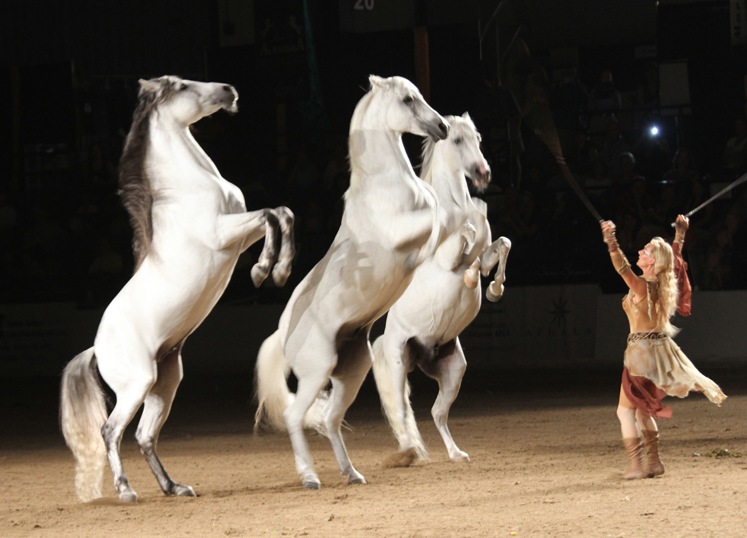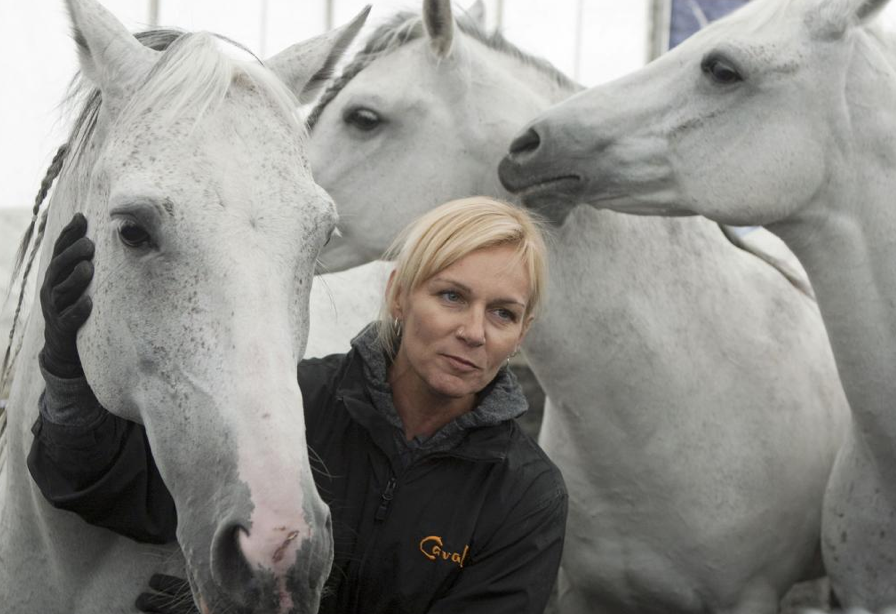Planning for Passionate Attendees
On October 24, 2013 by Admin Organizers increased attendance and media coverage at an annual Arabian Horse Show by adding unique entertainment that would excite the audience.
Organizers increased attendance and media coverage at an annual Arabian Horse Show by adding unique entertainment that would excite the audience.
By Kevin Woo September 2013
VIPs can be a pretty finicky bunch. Some demand nice comfy beds. Some want their quarters away from others, so as not to be disturbed, while others want to be situated in the middle of the action. Still others require a daily sponge bath, prodigious amounts of food and someone to escort them everywhere they go.
While it may seem as though Kate Cooper organizes a convention for divas, she doesn’t. Instead, she works for the Arabian Horse Association (AHA) and co-manages the annual U.S. National Arabian & Half-Arabian Championship Horse Show, which showcases the country’s best Arabian, Half Arabian and Anglo-Arabian horses who compete for the title of U.S. National Champion. The event takes place each October in Tulsa, Okla., has 25,000 attendees and 1,850 VIP horses that need round-the-clock attention.
Throughout each year there are 250 local Arabian competitions and 18 regional shows but the U.S. Nationals is considered to be the premier event. Winning a U.S. National Championship is the most prestigious honor an owner, rider or trainer can earn.
Cooper, a MPI Rocky Mountain Chapter member, has been training to be an event planner for a horse shows her entire life. She grew up in Arizona, where she owned, rode and showed horses. She played polo while attending Colorado State University, and after college she became an event planner with AHA, eventually working her way up to her current position as a special events manager.
The Oldest Breed
Arabians are the world’s oldest breed of horse, though archeologists don’t exactly agree on their origin. Some believe that Arabians were first discovered in the area that is now northern Syria and southern Turkey, while others believe that the first Arabians were found running across the Euphrates River and along the coast of Egypt. What is consistent among the archeologists is that the breed dates to 2500 B.C. The archeologists also agree that every horse, regardless of breed, can be traced back to the Arabian.
Arabians are easily identified by their distinct head shape and high tail carriage. The breed is well known for its stamina and is especially proficient in equestrian competitions such as horse racing, dressage, cutting, reining, endurance riding and show jumping. And because the Arabians have been raised among people, they’re especially gentle and social.
“Arabian horse people tend to be extremely passionate; they’re not your average horse person,” Cooper says. “They love the Arabian horse. They love the history that comes with the horse. They also love the personality that comes with Arabians. It’s more than a pet. It’s also a partner since it can carry you around when you’re out somewhere.”
The Décor
At the conclusion of the 2011 U.S. National event, the AHA event planning team polled the vendors and partners to see what changes could be made for the 2012 competition to spiff up the exhibition and competition areas. The surveys said that both areas were a bit drab and lacking in character. To solve this problem, AHA staff looked to Christine Ryan, “The Volunteer Extraordinaire,” to help make changes.
The first thing Ryan did was call on her friends and partners to raise the money to decorate the two largest performance areas of the event: the Pavilion and the Ford Truck Arena. Nearly everyone said yes to Ryan’s request for money, who eventually raised more than US$10,000.
“I wanted the Pavilion and Ford Truck Arena to feel like the competitors were riding into a national ring,” Ryan says. “So I thought, ‘What if we could dress up the entrance?’ and then we came up with the idea of an archway, banners, etc., and from there it just grew. We felt that (since we decorated) the entrance, we should try to decorate the walls, the seating areas and the runway. The amount of space that we decorated just kept growing.”
After decorating the two show areas, Ryan devoted her attention to making the vendor area look more like an exhibit hall.
Dawn Garland, one of Ryan’s volunteers, says the involvements made a tremendous difference to the show.
“The feedback was extremely positive,” Garland says. “Everyone feels like it looks more sophisticated. The area that was called a cow pen or rodeo arena is now worthy of being called a national championship venue. Even the photographers gave two thumbs up on the new décor because it gave a colorful background for their pictures.”
Ryan’s effort is likely to help increase 2013 revenue. Eri Hook, AHA’s commercial exhibit & patron sales coordinator, is projecting a 15 percent increase in commercial exhibitor and vendor revenue for the 2013. “We hope to keep expanding the decorations and attraction. They lead to more traffic not only for the show but for the commercial exhibit area. The shopping expo is large piece of income for the show.”
Cirque du Arabians
In addition to the new décor, AHA staff wanted to conclude the 10-day event with a splash—something big, spectacular and new to the conference. They reached out to Sylvia Zerbini to see if she would bring her show horses to perform.
For four years, Zerbini and her horses starred with Cavalia, which is an equine version of Cirque du Soleil.
The show, called Grande Liberté, features seven Arabians running loose in the arena around Zerbini doing tricks such as standing on their hind legs, kneeling down on their front knees and performing synchronized marching.
Zerbini and her entourage drew a capacity crowd of 3,900, a 160 percent increase over the prior year’s closing act. She left the crowd in awe of her talent.
“At the U.S. Nationals, you have the best trainers in the country in attendance,” Cooper says. “Yet after the show, you saw the trainers lined up to meet Sylvia and get her autograph. They were just in awe of her and what she can do with her horses.”
Part of Cooper’s job was to iron out all the details for Zerbini’s horses while they were stabled prior to the show. Based on experience, she knew the horses needed all the basics like grooming, water, food and shavings for bedding.
But her history of showing horses triggered another idea.
“It was a given that these horses were especially well trained,” Cooper says. “But I wanted to do more to make sure they were comfortable and keep them calm when it got close to performance time. I got to thinking about lighting, audiovisual, music and where we were going to put these horses before they go on stage. How would the horses react?”
Part of the lighting that Zerbini used was dark and mystical. It added to the flavor to the show but the organizers had to keep in mind that the horses still needed to be able to see Zerbini because so many of her cues to the horses are visual. Also, certain horses were highlighted to do individual tricks at specific times so the event planners decided they needed to install very dim lighting and coordinate four spotlights to help the Arabians see Zerbini.
Cooper added that the production crew had to keep the “ready” area dark so the audience couldn’t see what was happening next while the horses were still able to see Zerbini’s cues.
Zerbini’s music, which is very also very dramatic and beautiful also lends to her choreography. The production staff had go through many sound tests to ensure that the music was loud enough to give the full effect but soft enough that the horses could still hear Zerbini call them. If the horses couldn’t hear Zerbini when they weren’t looking directly at her, they could miss their cues.
To work out all these details Cooper found time when the center ring wasn’t being used to run a full rehearsal so the horses (and Zerbini) could get used to the music and lights. Not only did the rehearsal go off without a hitch, so did the show.
“There were huge stakes for AHA when we booked Sylvia,” Cooper says. “The sponsor covered all up-front costs associated with Sylvia’s performances and paid for the title sponsorship of the show. If we didn’t keep the sponsor happy, we would have had to cover those costs and thus had a losses.”
Cooper added that Zerbini’s participation generated twice the amount of media coverage from the previous year, and many local media outlets that covered the opening of the competition returned to cover closing night.
To reach out to the Tulsa community, AHA hosts an event called the Total Arabian Interaction and Learning (TAIL) program. Locals are invited to take a behind-the-scenes tour of the show so they can become more familiar with the breed, see how the show is produced, tour the barns and meet an Arabian horse. TAIL is promoted through a partnership with the Tulsa CVB, FFA (formerly known as Future Farmers of America), home schooling families and Girl Scouts.
To further promote competition, everyone who attended a TAIL tour received free family passes to one of the three final performances. The idea is to boost attendance (and revenue) at the U.S. National event. In 2012, more than half of the passes were redeemed for at least one of the competitions.
For the city of Tulsa, hosting the event is also a win-win. The economic impact for the city is about $30 million annually.
Cooper says her colleagues at MPI continue to push her to new heights and helped her mature as a meeting professional They’ve taught her new techniques and exposed her to meeting experiences that she’d never otherwise have been exposed to.
“I was always meant to do (this). What I love about being a planner is having a goal – a great meeting or event – figuring out all of the pieces, and ultimately pulling it off. I walk away from an event with a sense of accomplishment, always with something new that I have learned and the sense that I have completed a goal. This job is not the same day-to-day, everything changes; there are always new challenges and curve balls. I’ve learned that being a meeting planner, a good meeting planner, forces me to problem solve.
“As for the big picture for my career overall, the 2012 show reinforced to me how much a working team of staff and volunteers can get accomplished and how we can make such a difference with that attitude.”
Archives
- February 2019
- January 2019
- September 2018
- June 2018
- March 2018
- February 2018
- July 2016
- March 2016
- January 2016
- November 2015
- February 2015
- January 2015
- December 2014
- June 2014
- May 2014
- February 2014
- January 2014
- October 2013
- August 2013
- July 2013
- June 2013
- May 2013
- April 2013
- March 2013
- February 2013
- January 2013
- December 2012
- November 2012
- September 2012
- May 2012
- April 2012
- March 2012
- June 2009
Calendar
| S | M | T | W | T | F | S |
|---|---|---|---|---|---|---|
| 1 | 2 | 3 | 4 | 5 | ||
| 6 | 7 | 8 | 9 | 10 | 11 | 12 |
| 13 | 14 | 15 | 16 | 17 | 18 | 19 |
| 20 | 21 | 22 | 23 | 24 | 25 | 26 |
| 27 | 28 | 29 | 30 | |||
